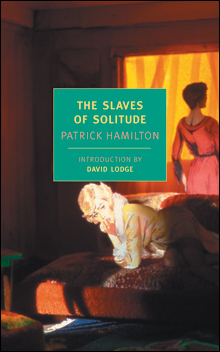
BATTLE LINES: Hamilton’s middle-class Briton who suspected fascism might not be such a bad thing is the type of blowhard who exists in every era. |
‘I’ve been at home for six months and the war still goes on . . . We have our dead here, too.’
— Cesare Pavese, The House on the Hill
It’s perhaps understandable that what we think of as “the war novel” has become synonymous with stories set in the midst of combat. But it fails to take into account the fact that often the people irreversibly marked by war are those who are nowhere near the fighting, resulting in strange exclusions. For instance, James Jones’s The Thin Red Line would qualify as a war novel, but his From Here to Eternity, which climaxes with the attack on Pearl Harbor, would not. Equating war novels with combat novels would also rule out Alberto Moravia’s Two Women — for my money, one of the half-dozen greatest World War II novels.
Patrick Hamilton’s 1947 The Slaves of Solitude, set in London during the Blitz, and Alfred Hayes’s 1949 The Girl on the Via Flaminia, set in liberated Rome while the war continues elsewhere, are two of the ongoing series of fiction reissues that has been a boon for contemporary readers (and made much contemporary fiction pale in comparison). They are both war novels without a single combat scene. Hamilton’s book is set in a shabbily respectable boarding house on the outskirts of London, Hayes’s in a not-so-respectable boarding house (the owner has turned it into a place for prostitutes to lodge or bring their regulars) frequented by the Allied liberators.
Even without American GIs figuring in the plots of both books, without the air raids and rationing Hamilton writes of, and the resentment of the defeated Italian soldier in Hayes, the war would be present in the very fiber of these novels. The combat novel gives us soldiers who do things that would have previously been unthinkable for them. The women in these two novels don’t face such drastic moral choices, such slim chances of survival. But in the way that war has narrowed their choices, has made life feel small and dingy and besotted with the grey reality of the combat taking place elsewhere, each finds herself in situations that are unthinkable enough.
Patrick Hamilton is best known for writing the plays that were the basis of the films Gaslight and Rope, and for the terrifying hardboiled novel of London in the ’30s Hangover Square (recently republished by Europa Editions). The Slaves of Solitude isn’t as dark a book as Hangover Square (almost no novels are). It has wit and bite and you’re never put in the position of fearing that disaster awaits the heroine, Miss Roach (that is how she is known throughout). The genre Hamilton is writing in desperately needs those qualities because English novels about the small undignified familiarities of boarding house life can suck the life out of you even when (as in Elizabeth Taylor’s Mrs. Palfrey at the Claremont) they’re good. (Anita Brookner’s tales of pinched drab lives can have you reaching for the straight razor.)
 Related
Related:
Major minor, Fighting words, Inside fight, More 
- Major minor
Hamilton’s newly re-issued 1941 novel Hangover Square makes almost all other hard-boiled writing seem phony.
- Fighting words
Imagine that suicide bombers have just blasted three American shopping malls.
- Inside fight
By all accounts, Thursday, February 9 was a red-letter day for US Senate candidate Matt Brown.
- Reality bites
The war in Iraq has been on the back burner of the American political scene for some time.
- Trying out an anti-demonstration ‘sonic cannon’
The Maine Marine Patrol is considering purchasing a “sonic cannon” capable of broadcasting earsplitting, “disorienting” sounds, like those that have been used to break up peaceful demonstrations in public spaces in Iraq and the country of Georgia.
- Afghanistan: Just say no!
The idea that the war in Afghanistan has reached a critical junction, a “now-or-never” moment that requires an additional 40,000 troops to win, is rubbish.
- Rent a war
Wonder why the Iraq government changed its mind about expelling Blackwater, the rent-a-soldier company whose employees killed 17 civilians this past month?
- The outsiders
Just a few months ago, the story-line of Maine’s 2008 US Senate race seemed inevitable.
- War all the time
War is hell and all that, but deep down you desperately want to know what it was actually like.
- Numbing carnage
On the morning of March 8, viewers had their first sip of coffee to a grisly sight on the news shows: grainy video of roughly two-dozen dead Iraqis lined up in a makeshift morgue, many of them apparently bound and strangled.
- Less

 Topics
Topics:
Books
, Culture and Lifestyle, Elizabeth Taylor, History, More  , Culture and Lifestyle, Elizabeth Taylor, History, World History, World War II, U.S. Armed Forces Activities, U.S. Army Activities, Alberto Moravia, Patrick Hamilton, Cesare Pavese, Less
, Culture and Lifestyle, Elizabeth Taylor, History, World History, World War II, U.S. Armed Forces Activities, U.S. Army Activities, Alberto Moravia, Patrick Hamilton, Cesare Pavese, Less 